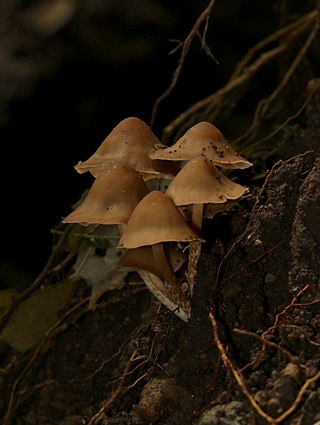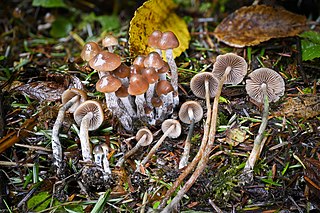
Psilocybe ovoideocystidiata is a psilocybin mushroom, having psilocybin and/or psilocin as main active compounds. It is closely related to P. subaeruginascens from Java, P. septentrionalis from Japan, and P. wayanadensis from India. This mushroom was first documented by Richard V. Gaines in Montgomery County, Pennsylvania in June 2003. Although it is sometimes confused with Psilocybe caerulipes, it can be distinguished by its rhomboid spores, larger stature, earlier fruiting season and membranous annulus.

Psilocybe mescaleroensis is a psychedelic mushroom which has psilocybin and psilocin as main active compounds. This mushroom is closely related to Psilocybe hopii and Psilocybe cyanescens. It was brought to scientific attention by Lee Walstad.

Psilocybe meridionalis is a psychedelic mushroom which has psilocybin and psilocin as main active compounds. This mushroom is closely related to Psilocybe stuntzii but can be distinguished by its smaller spores and the presence of pleurocystidia. This is the only species of Psilocybe from section Stuntzii which has been found in Mexico. It is known only from the type location in Neverias, Sierra de Cacoma, Jalisco, Mexico.
Psilocybe acutipilea is a species of mushroom-forming fungus in the family Hymenogastraceae. It was discovered in October 1881 in Apiahy, Sao Paulo State, Brazil by Carlos Spegazzini, and described by him as a new species of Deconica in 1889. Gastón Guzmán transferred it to Psilocybe in 1978, but Ramirez-Cruz considered it a possible synonym of Psilocybe mexicana, but the type specimen was too moldy for them to be certain.

Psilocybe banderillensis is a species of psilocybin mushroom in the family Hymenogastraceae known from the states of Veracruz and Oaxaca in Mexico. It is in the Psilocybe fagicola complex with Psilocybe fagicola, Psilocybe oaxacana, Psilocybe columbiana, Psilocybe herrerae, Psilocybe keralensis, Psilocybe neoxalapensis, and Psilocybe teofiloi.
Psilocybe columbiana is a species of mushroom in the family Hymenogastraceae known only from the páramos of high mountains in Colombia. It is in the Psilocybe fagicola complex with Psilocybe fagicola, Psilocybe oaxacana, Psilocybe banderillensis, Psilocybe herrerae, Psilocybe keralensis, Psilocybe neoxalapensis, and Psilocybe teofiloi.

Psilocybe fagicola is a species of psychedelic mushroom in the family Hymenogastraceae native to Mexico. The type specimen for the species was collected in 1959 in a beech forest in Hidalgo, Mexico.
Psilocybe herrerae is a species of psilocybin mushroom in the family Hymenogastraceae. The mushroom was first described by Mexican mycologist Gastón Guzmán. It contains the compounds psilocybin and psilocin. Psilocybe herrerae is known only from the states of Chiapas and Veracruz, Mexico. It is in the Psilocybe fagicola complex with Psilocybe fagicola, Psilocybe oaxacana, Psilocybe banderillensis, Psilocybe columbiana, Psilocybe keralensis, Psilocybe neoxalapensis, and Psilocybe teofiloi.

Psilocybe moseri is a species of mushroom in the family Hymenogastraceae. The mushroom contains the medicinal compound psilocybin. It is in the section Zapotecorum of the genus Psilocybe, other members of this section include Psilocybe muliercula, Psilocybe angustipleurocystidiata, Psilocybe aucklandii, Psilocybe collybioides, Psilocybe kumaenorum, Psilocybe zapotecorum, Psilocybe kumaenorum, Psilocybe subcaerulipes, Psilocybe pintonii, Psilocybe zapotecoantillarum, Psilocybe zapotecocaribaea, and Psilocybe antioquiensis.
Psilocybe subcaerulipes is a species of fungus in the family Hymenogastraceae. It is in the section Zapotecorum of the genus Psilocybe, other members of this section include Psilocybe muliercula, Psilocybe angustipleurocystidiata, Psilocybe aucklandii, Psilocybe collybioides, Psilocybe kumaenorum, Psilocybe zapotecorum, Psilocybe pintonii, Psilocybe graveolens, Psilocybe moseri, Psilocybe zapotecoantillarum, Psilocybe zapotecocaribaea, and Psilocybe antioquiensis. It is endemic to Japan. Fruit bodies grow on the ground in woody debris, and typically stand 6 to 8 cm tall with caps that are 2.5 to 5 cm in diameter. They are chestnut brown, and stain blue if bruised or handled. The species is a psychoactive mushroom, and contains the hallucinogenic compounds psilocybin and psilocin. There have been reports of poisoning caused by the accidental consumption of this mushroom. It has been used in research, specifically, to test the effects of its consumption of marble-burying in mice, an animal model of obsessive-compulsive disorder.
Psilocybe zapotecoantillarum is a species of mushroom in the family Hymenogastraceae. The mushroom contains the medicinal compound psilocybin. It is in the section Zapotecorum of the genus Psilocybe, other members of this section include Psilocybe muliercula, Psilocybe angustipleurocystidiata, Psilocybe aucklandii, Psilocybe collybioides, Psilocybe kumaenorum, Psilocybe zapotecorum, Psilocybe kumaenorum, Psilocybe subcaerulipes, Psilocybe pintonii, Psilocybe moseri, Psilocybe zapotecocaribaea, and Psilocybe antioquiensis.
Psilocybe zapotecocaribaea is a species of mushroom in the family Hymenogastraceae. The mushroom contains the medicinal compound psilocybin. It is in the section Zapotecorum of the genus Psilocybe, other members of this section include Psilocybe muliercula, Psilocybe angustipleurocystidiata, Psilocybe aucklandii, Psilocybe collybioides, Psilocybe kumaenorum, Psilocybe zapotecorum, Psilocybe kumaenorum, Psilocybe subcaerulipes, Psilocybe pintonii, Psilocybe moseri, Psilocybe zapotecoantillarum, and Psilocybe antioquiensis.

Psilocybe pelliculosa is a species of fungus in the family Hymenogastraceae. The fruit bodies, or mushrooms, have a conical brownish cap up to 2 cm in diameter atop a slender stem up to 8 cm long. It has a white partial veil that does not leave a ring on the stem. American mycologist Alexander H. Smith first described the species in 1937 as a member of the genus known today as Psathyrella; it was transferred to Psilocybe by Rolf Singer in 1958.

Psilocybe neoxalapensis is a species of psilocybin mushroom in the family Hymenogastraceae. Found in Veracruz, Mexico, it was originally described in 2005 under the name Psilocybe novoxalapensis, but this naming was later determined to be invalid, and it was renamed P. neoxalapensis in 2009. It is in the Psilocybe fagicola complex with Psilocybe fagicola, Psilocybe oaxacana, Psilocybe banderillensis, Psilocybe columbiana, Psilocybe keralensis, Psilocybe herrerae, and Psilocybe teofiloi.
Psilocybe oaxacana is a species of psychedelic mushroom in the family Hymenogastraceae native to Oaxaca, Mexico. It is in the Psilocybe fagicola complex with Psilocybe fagicola, Psilocybe banderillensis, Psilocybe columbiana, Psilocybe herrerae, Psilocybe keralensis, Psilocybe neoxalapensis, and Psilocybe teofiloi.
Psilocybe singularis is a species of psilocybin mushroom in the family Hymenogastraceae. Found in Oaxaca, Mexico, where it grows on bare clay soil in mesophytic forest, it was described as new to science in 2004.
Psilocybe subhoogshagenii is a species of psilocybin mushroom in the family Hymenogastraceae. Described as new to science in 2004, it is found in Colombia, where it grows on bare clay soil in tropical forest.
Psilocybe subheliconiae is a species of psilocybin mushroom in the family Hymenogastraceae. Described as new to science in 2004, it is found in Colombia, where it grows on the rhizomes of Araceae plants.







